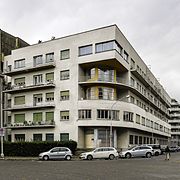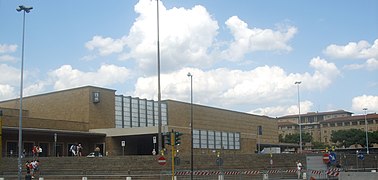Rationalism (Italy)
The rationalism (Razionalismo) is an architectural style movement of the late 1920s and 1930s in Italy, through a rationalization like reinforced concrete, steel and glass was characterized in terms of abstraction that time revolutionary by reduction of basic architectural elements and the conscious use building materials. After the First World War, rationalism was largely developed by northern Italian architects (including Giuseppe Terragni and Gruppo 7 ). It sees itself as a revolutionary attitude towards the academic styles , which u. a. were taught at universities and academies ( historicism , neoclassicism , eclecticism , novecento) . The razionalismo can generally be understood as a part of the architectural modernism at the beginning of the 20th century. It marks Italy's architectural departure into the modern age. This is all the more true, especially since Italy, as Bruno Zevi remarked, "produced neither a Wright, nor a Gropius, a Le Corbusier, a Mendelsohn, a Mies or aalto" ().

From an architectural-political point of view, it is noteworthy, among other things, that the rationalist movement in Italy soon came to a point of understanding itself as the architecture of fascism . Ernesto Nathan Rogers , a member of the BBPR group and protagonist of Italian modernism, has retrospectively pointed out that this alliance shared by Terragni, Pietro Maria Bardi and large parts of the Gruppo 7 was a mistake: “I think that our mistake lies in a philosophical misunderstanding. We invoked a logical conclusion that went something like this: Fascism is a revolution, the architecture of modernity is revolutionary, consequently it must be the architecture of fascism. "
A basic architectural type of rationalism is the skeleton construction, without a curtain decorated facade with a square pillar colonnade on the ground floor or the mezzanine floor accessible via generous stairs, regular window structure in a static grid or in a perforated facade and orthogonal steel or aluminum profile frame subdivision of the window panes. Often the exposed concrete facades were painted, plastered or clad with natural stone slabs (including travertine ) despite the high demands on abstraction .
Goal of the rationalists
The aim of the movement was the modernization of Italian architecture through rationalization , i.e. the renunciation of applied ornamentation, the reduction of the floor plan with the help of simplification to basic architectural types (also with reference to building types from Roman and Greek antiquity and the Renaissance : temple , basilica , Rotunda , dome and their style elements such as the arcade ). Quoting historical architectural styles in the sense of eclecticism was deliberately rejected. Archetypes were rationalized through an abstraction process and adapted to the contemporary structural conditions. For example, the type of the Roman arcade was reduced to an orthogonal colonnade with capitalless square pillars, or pilasters , which can fulfill a load-bearing or non-load-bearing function in their application, were consciously designed as load-bearing elements and not as an ornamental application of a part of the building, around the one demanded by the rationalists Functional fulfillment of the architecture . In spite of all of this, according to the self-image of its protagonists, Razionalismo was by no means free of historical, especially classical references. In the sense of his abstract moments, he consciously referred to Roman antiquity, as shown, for example, by the quality of order and rhythm in Giuseppe Terragnis' works. As a 'rationalized' classicism, it is based on “the purity, the absolute, the proportions, the mathematical relationships” (), which are ultimately also the characteristics of classical architecture.
The Rationalist Movement was organized in MIAR (Movimento Italiano per l'Architettura Razionale) chaired by Adalberto Libera from 1930 until its dissolution by the National Fascist Architects Association on May 9, 1931 . This association emerged from Gruppo 7 founded in 1926 .
Group 7 manifesto
The essential points of Razionalismo were recorded in writing in the 4 notes of the Manifesto of Gruppo 7 . The Gruppo 7 consisted of seven graduates of the Milan Polytechnic: Gino Pollini, Giuseppe Terragni, Adalberto Libera, Luigi Figini, Sebastiano Larco, Carlo Enrico Rava and Guido Frette.
The 4 parts of the manifesto were published one after the other:
- Part 1: Architettura (architecture), December 1926,
- Part 2: Gli Stranieri (The Foreigners), February 1927,
- Part 3: Impreparazione, incomprensione, pregiudizi (lack of preparation, incomprehension, prejudice), March 1927,
- Part 4: Una nuova epoca arcaica (A New Epoch of Classics), May 1927.
Quotes
The new architecture, the real architecture, must result from a close connection with logic and rationality. We are not entitled to create a new style; we always use rationality. [...] The beauty arises from the refinement of the abstract perfection of a pure rhythm, which does not yet appear noble, as well as the simple construction, which alone would not contain any beauty. [...] The desire for honesty, the desire for order and logic and above all clarity, these are the real characteristics of this new spirit. (Rassegna Italiana, 1926)
“The essence of rationalistic classicism is not based on a mimetic recourse to a particular epoch - be it the Renaissance or another. Rather, it is a timeless, universal classicism that is looking for an order, a measure, a modulation that, when viewed in light, makes the architectural forms tangible according to their essence and their relationships with one another as parts of a unity. "
“In the critical terminology of modern architecture, the term 'organic' has now decisively replaced the term 'rational'. The antithesis fitting between 'organic' and 'constructive' corresponds to these two views. European architecture, which made the figurative experience of Cubism its own, called itself rational: Just to cite its high points, I mention the architecture of Le Corbusier and von Gropius. There is no doubt that architectural rationalism also displays a strictly conspicuous, anti-traditionalist attitude: this means, transferred, that it seeks an absolute value in geometric form that goes beyond all historical meanings. But to attain the essential reality one has to go beyond the decomposition of certain empirical values, bring nature back from the confused accumulation of externals to the mathematical laws. One does not want to exclude the naturalistic of the forms of appearance, but rather reform it according to the fundamental rules of reason; not refuting a worldview, but correcting its mistakes; do not raise the problem of conscience and life anew, but straighten out the absurdities. Even the contradictions of history can be challenged more than ever, because sooner or later every great artist of the past will be exposed as a rationalist or a cubist. (...) We can look at the so-called architectural 'rationalism' as a logical analysis or criticism of the tradition that is focused on discovering the authentic and original principles to the restoration of essential values: That's why it is, even if it is against the academic classicism, to an ideal classicism and against a habitual naturalism to the foundations of the idea of nature. "
Buildings (selection)
- Angiolo Mazzoni : Rosa Maltoni Mussolini holiday home in Calambrone (Pisa), 1925–26.
- Giuseppe Terragni : Novocomum, Housing in Como, 1926–29.
- Giuseppe Pagano and Gino Levi-Montalcini : Palazzo Gualino, housing in Turin, 1928–30.
- Gino Pollini and Luigi Figini : Casa Elettrica , Monza, 1930.
- Giuseppe Capponi : Botanical Institute on the campus of La Sapienza University in Rome, 1932–34.
- Giovanni Michelucci and others (Gruppo Toscano) : Santa Maria Novella train station , Florence, 1932–34.
- Giuseppe Terragni: Casa del Fascio. Como, 1932-1936.
- Luigi Moretti : Casa GIL , Trastevere, Rome, 1933.
- A group of architects around Eugenio Montuori and Luigi Piccinato : planning of the urban complex of Sabaudia with the central buildings Casa del Fascio , town hall and the church Santissima Annunziata , 1933–34.
- Mario Ridolfi : Palazzo dello Poste in Piazza Bologna, Rome, 1933–35.
- Giuseppe Terragni: Sant'Elia Kindergarten in Como, 1936–37.
- Guido Pellizzari, Francesco Rossi and Luis Plattner: House of the Fascist Party , Bozen, 1939–1942.
- Giuseppe Pettazzi : Fiat Tagliero petrol station , Asmara , Eritrea .
Giuseppe Terragni Novocomum, Como 1926-1929.
Mario Ridolfi Palazzo dello Poste, Rome 1933–1935.
Giovanni Michelucci Firenze Santa Maria Novella station , Florence 1932–1934.
Further development
Italian rationalism was taken up again in neorationalism from the 1960s, whose Italian current is called Tendenza (after the 1973 exhibition).
literature
- Carmen M. Enss and Luigi Monzo (eds.): Townscapes in Transition. Transformation and Reorganization of Italian Cities and Their Architecture in the Interwar Period. Bielefeld 2019, ISBN 978-3-8376-4660-3 .
- Luigi Monzo: Croci e fasci - Italian church building in the time of fascism, 1919–1945. 2 vol. Karlsruhe 2017 (dissertation, Karlsruhe Institute of Technology, 2017), pp. 125–128 and 770–890.
- Silvia Danesi, Luciano Patetta: Il Razionalismo e l'architettura in Italia durante il fascismo. Venice 1976.
- Terry Kirk : The Architecture of Modern Italy. Vol. 2: Visions of Utopia. New York 2005, ISBN 1-56898-436-7 .
- Ueli Pfammatter: Modernity and Power. 'Razionalismo', Italian Architects 1927–1942. Braunschweig 1990, ISBN 3-528-08785-4 .
- Rosario De Simone: Il razionalismo nell'architettura italiana del primo Novecento. Rome / Bari 2011, ISBN 978-88-420-9598-9 .
Web links
- Razionalismo italiano , extensive collection of flickr architectural photos on rationalism (Italian, accessed October 26, 2013)
Individual evidence
- ^ Bruno Zevi: Giuseppe Terragni. Zurich 1989, p. 18
- ^ Ernesto Nathan Rogers: L'esperienza degli architetti. In: Fascismo e antifascismo. Milan 1976, p. 335.
- ^ Ellen R. Shapiro: Ojetti e Terragni: classicismo, razionalismo, fascismo. In: Giorgio Ciucci (ed.): Giuseppe Terragni. Opera completa. Milan 1996, p. 221.
- ^ Giorgio Ciucci (ed.): Introduzione. In: Thomas L. Schumacher: Il Danteum di Terragni. Rome 1980, p. 12
- ^ Ueli Pfammatter: 'Razionalismo': Italian architects 1927–1942. Braunschweig / Wiesbaden 1990, "Architecture and a New Era of Classics - The Four Writings of Gruppo 7", p. 164ff.
- ↑ Ignazio Gardella : Un ricordo. In: Giorgio Ciucci (ed.): Giuseppe Terragni . Opera completa. Ciucci, Milan 1996, p. 8.
- ^ GC Argan : Frank Lloyd Wright. In: Metron. 1947 cit. n. Franco Fonatti : Giuseppe Terragni. Poet of Razionalismo. Vienna 1987, p. 23.
-
^ P. Wilkinson: Neorationalism. Neorationalism. In: 50 key architecture ideas. Springer Spektrum, Heidelberg 2013 (at springer.com, accessed November 20, 2019).
Neorationalism. HiSoUR.com-



